타이어산업의 재해분석을 통한 상대위험도 지수에 관한 연구
- Alternative Title
- A study on the Relative Risk Index of Tire Industrial Injury
- Abstract
- The occurrence of disasters in the industrial field is caused by a combination of factors such as personal factors (human factor), machine elements (material factor), working conditions, and business environment (environmental factor). In order to prevent such industrial accidents, researches are actively pursued in various ways, and there are two main strategies. The first is to prevent recurrence by analyzing fundamentally cause of occurrence, eliminating and isolating the cause, and the second is to determine how many industrial accidents will occur in the future. There is a way to predict in advance based on information, to establish preventive strategies in the short and long term, to respond timely, and to prevent them (feed-forward). This study developed the relative risk index related to various environmental factors based on industrial accident data to prevent disasters.
In this study, based on the 9 - year disaster information from tire manufacturing, the relative risk index was derived by analyzing the disasters by length of service, occurrence time, month, and rainy weather. Using the relative risk index, we predicted the risk of disaster by season, environment, and individual.
As a result of the 346 disaster analyzes from 2007 to 2015 of the subject A tire company, major disasters did not occur but minor disasters consistently occurred. As a result of the disaster analysis, the relative risk index for the years of service was the highest at the first year and the second highest at the second. The work type of company A is 3, 3 shifts. The working hours are from 06:00 to 14:00 for group A, from 14:00 to 22:00 for group B, and from 22:00 to 06:00 for group C. The relative risk index for the shift work hours of A company was high in the early part of shift work in all three shifts, followed by the end part of shift work and the middle part in the next order. In terms of time, the highest was from 14:00 to 16:40, which was the overlapping period between the early working hours of group B and the late working hours of weekly working hours. On the other hand, the lowest time was analyzed from 0 to 03:20. Monthly relative risk index was the highest in August and lowest in winter in December, January and February. Finally, the relative risk index in rainy days was higher than that in fine weather, and the relative risk index was higher in the first plant where air conditioning (temperature / humidity control) was insufficient compared to the second plant. If the development of the relative risk index combined with various factors related to the disaster occurrence is actively carried out and the data are actively used to predict the occurrence of the disaster and make an effort to eliminate or improve the potential risk factors, it can contribute to prevention and reduction of disasters in the tire industry.
- Issued Date
- 2017
- Awarded Date
- 2017. 8
- Type
- Dissertation
- Publisher
- 부경대학교
- Alternative Author(s)
- Jae Beom Shim
- Affiliation
- 부경대학교 산업대학원
- Department
- 산업대학원 안전공학과
- Advisor
- 장성록
- Table Of Contents
- 제 1 장 서 론
1.1. 연구의 목적
1.2. 연구의 필요성
제 2 장 연구배경 및 연구방법
2.1. 연구 배경
2.2. 연구 방법
2.3. 연구 대상
제 3 장 연구결과
3.1. 근속연수별 분석
3.1.1. 재해발생 현황
3.1.2. 상대위험지수
3.1.3. 상대위험도 결과에 따른 재해예방 대책
3.2. 근무시간별 분석
3.2.1. 재해발생 현황
3.2.2. 상대위험지수
3.2.3. 상대위험도 결과에 따른 재해예방 대책
3.3. 월별 분석
3.3.1. 재해 발생 현황
3.3.2. 상대위험지수
3.3.3. 상대위험도 결과에 따른 재해예방 대책
3.4. 날씨별 분석
3.4.1. 재해 발생 현황
3.4.2. 상대위험지수
3.4.3. 우천 시 상대위험도 결과에 따른 재해예방 대책
제 4 장 결론 및 고찰
- Degree
- Master
- Files in This Item:
-
-
Download
 타이어산업의 재해분석을 통한 상대위험도 지수에 관한 연구.pdf
기타 데이터 / 1.32 MB / Adobe PDF
타이어산업의 재해분석을 통한 상대위험도 지수에 관한 연구.pdf
기타 데이터 / 1.32 MB / Adobe PDF
-
Items in Repository are protected by copyright, with all rights reserved, unless otherwise indicated.